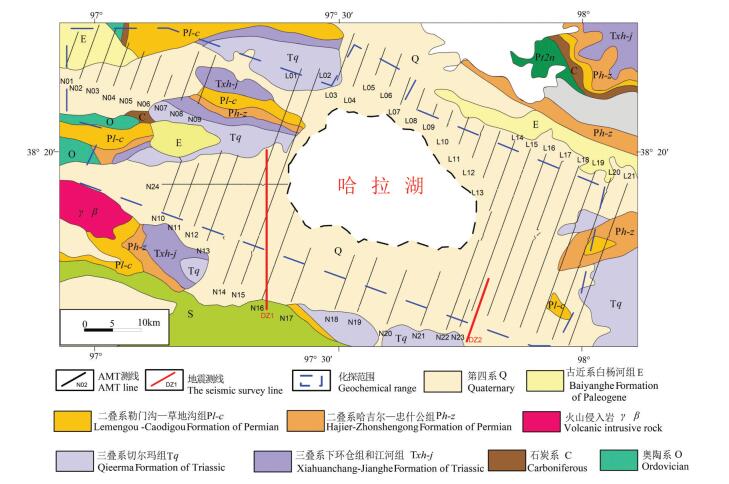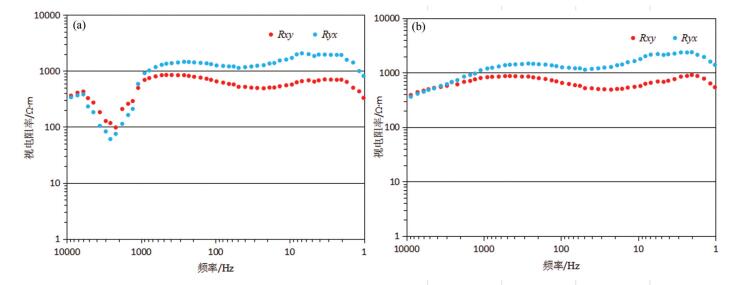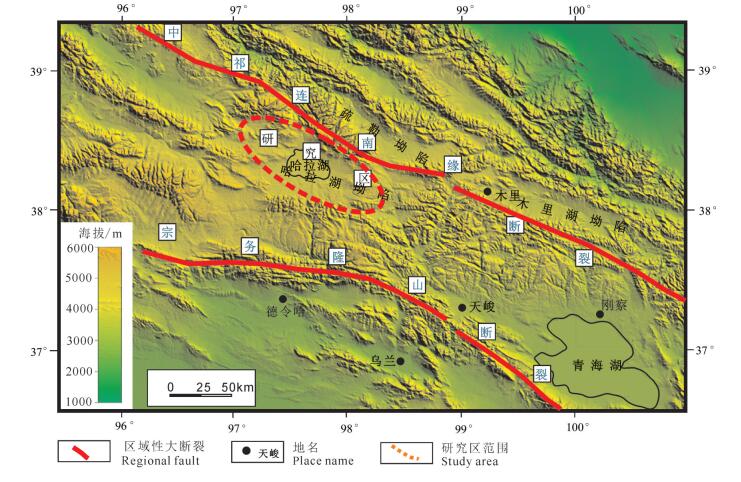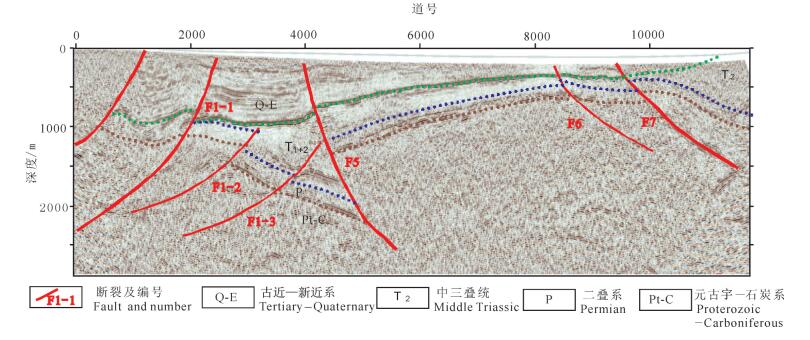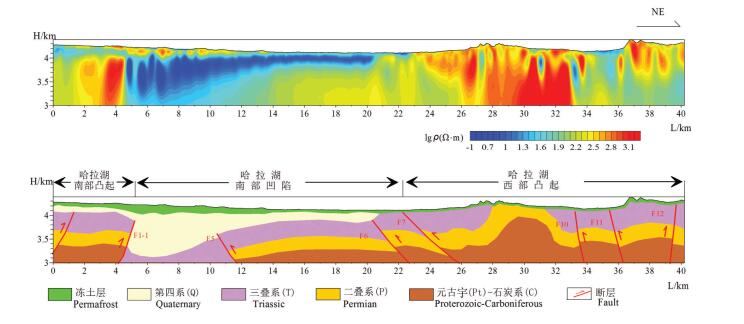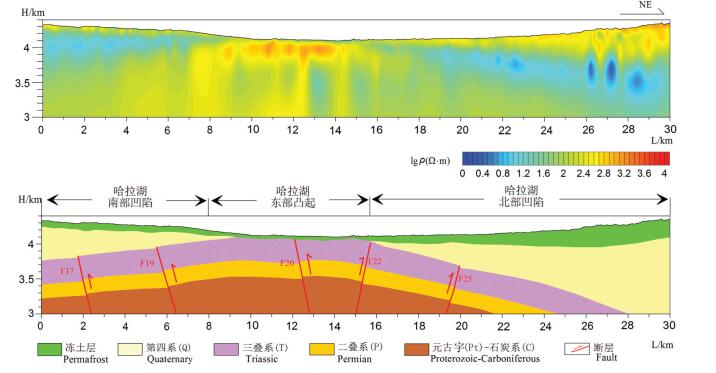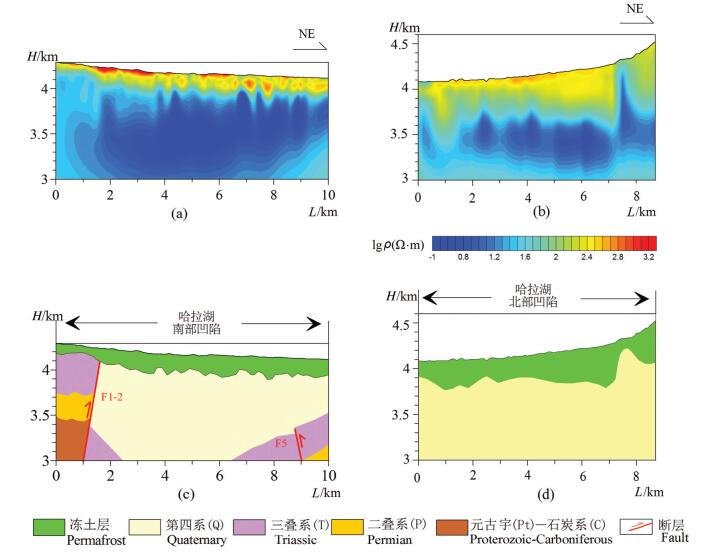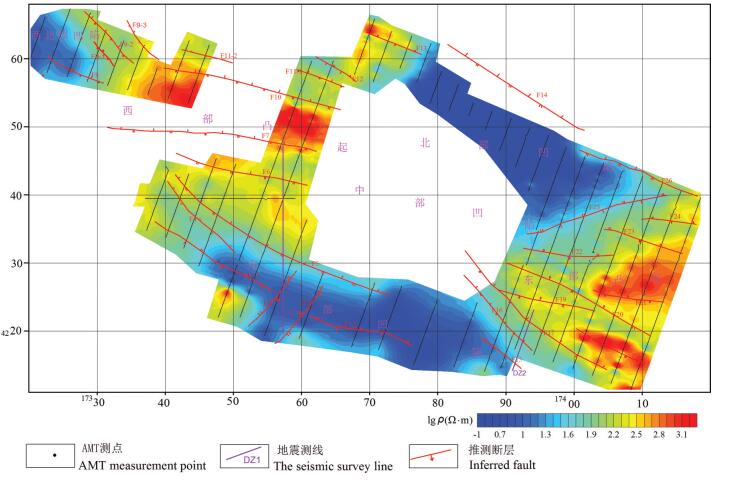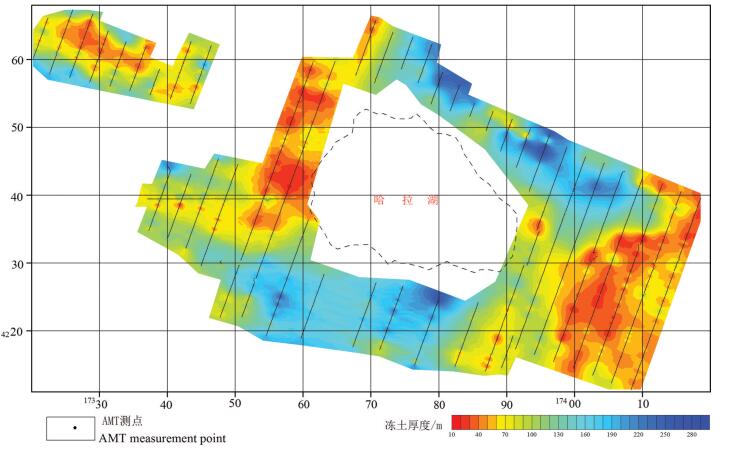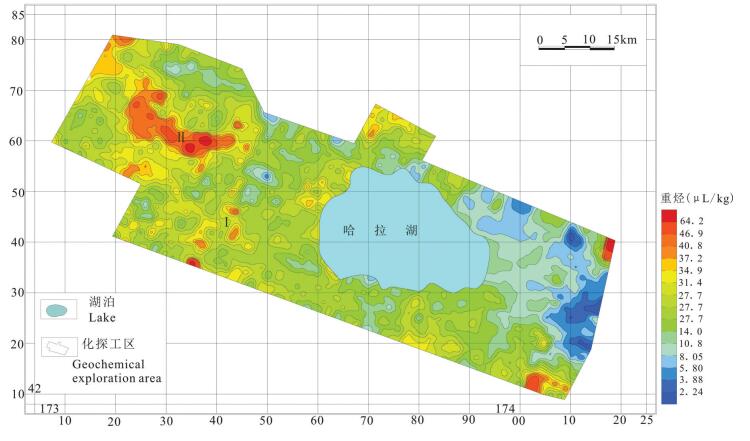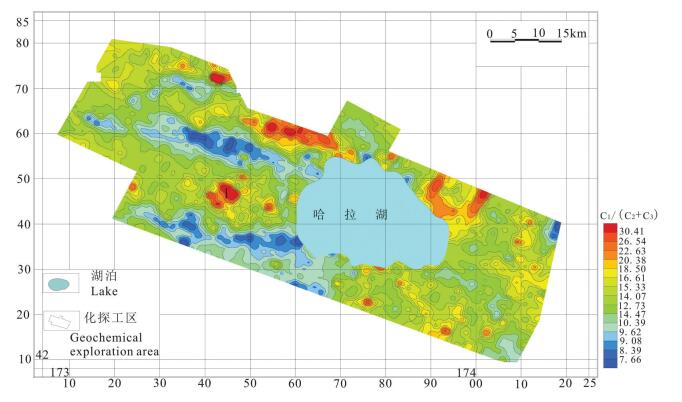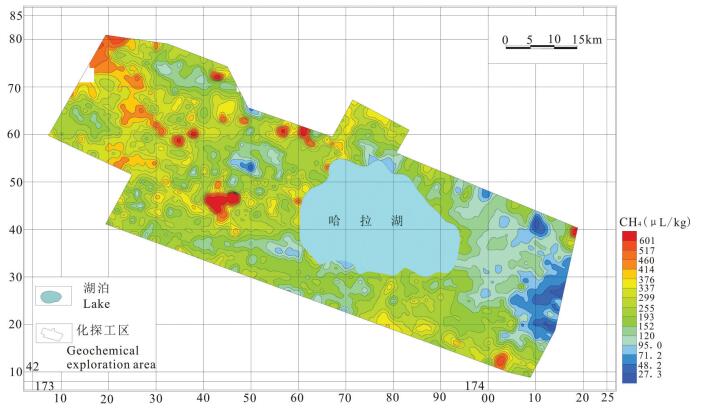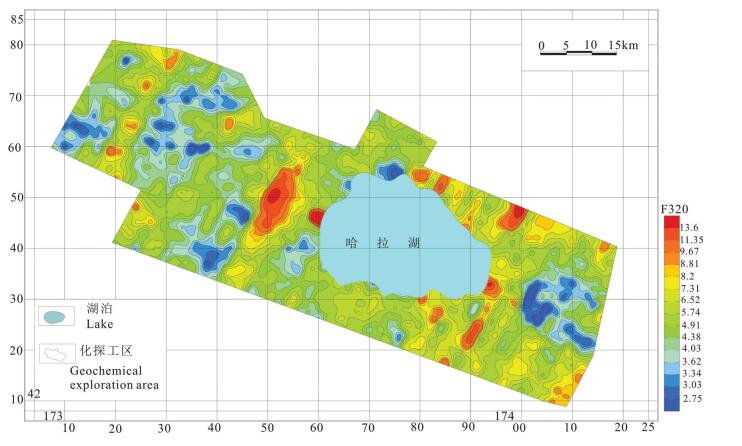A study of geological structural features of Hala Lake Depression in Qilian Mountain and reservoir-forming conditions of natural gas hydrate
-
摘要:
祁连山哈拉湖坳陷与已发现天然气水合物的木里坳陷同属于南祁连盆地次级坳陷,有相似的水合物成藏条件,但由于该区地质工作程度低,坳陷内第四系覆盖层下的地质构造信息不清,对该区的天然气水合物成藏条件缺乏认识。为查明哈拉湖坳陷的地质构造特征和天然气水合物成藏条件,在哈拉湖坳陷区内开展了物化探综合探测及研究,结果表明:(1)调查区内可划分出4个凹陷区、2个凸起区,调查区内可划分出26条断裂;(2)调查区永冻土层分布特征以新生界沉积区以大面积片状和基岩出露区以岛状分布为主,永冻土层发育与高程、地形、地表覆盖层及表层土壤水分等因素密切相关;(3)调查区发现了两处地球化学异常,以酸解烃重烃、酸解烃干燥系数、顶空气甲烷和荧光光谱为指标组合,显示了两种不同的异常特征类型,异常浓集中心明显,强度较高;(4)哈拉湖坳陷的烃原岩条件相对差,烃源岩的保存完整性和印支—燕山期圈闭构造是水合物成藏的关键,哈拉湖坳陷区北部和地球化学Ⅰ号异常区可为水合物成藏远景区。本文为南祁连盆地下一步天然气水合物资源调查与评价提供了依据。
Abstract:Both of the Hala Lake Depression in Qilian Mountain and the Muli Depression in which natural gas hydrate was found are depressions of the South Qilian Basin and have similar hydrate accumulation conditions. However, due to the low degree of geological work in the Hala Lake Depression, the geological structure information in the depression under the Quaternary overburden is unclear, and the gas hydrate accumulation conditions in this area are not well understood. In order to find out the geological structure characteristics and gas hydrate accumulation conditions of the Hala Lake Depression, the authors carried out a comprehensive study of geophysical and geochemical exploration in the depression. Some conclusions have been reached:(1) The investigation area can be divided into four sags, two salients and twenty-six faults; (2) As for the distribution characteristics of permafrost layers in the investigation area, the Cenozoic sedimentary areas are mainly in sheet distribution in large area and the outcrops of bedrock are mainly in island-shaped distribution; the development of the permafrost layer is closely related to factors such as elevation, topography, land cover and surface soil moisture; (3) Two geochemical anomalies were found in the investigation area, and the indicators combination of heavy hydrocarbon in acidolysis hydrocarbons, aridity coefficient of acidolysis hydrocarbons, methane in headspace gases and fluorescence spectra characteristics indicates that there are two different types of anomalous features characterized by an obvious anomalous concentration center with relatively high intensity; (4) The source rocks in the Hala Lake Depression are relatively poor, and the preservation integrity of source rocks and the Indosinian-Yanshanian trap structure are the key factors to hydrate accumulation. The northern part of the Hala Lake Depression and the No. I geochemical anomaly zone can be the prospective areas for hydrate accumulation, and these findings provide a basis for future investigation and evaluation of the gas hydrate resources in the South Qilian Basin.
-
1. 引言
四川盆地东部长兴组礁滩相储层为重要的天然气勘探目的层,且主要分布于开江-梁平海槽的东西两侧[1-5]。碳酸盐沉积后作用与储层储集性能的关系十分密切,碳酸盐岩孔隙的形成、增大、减少甚至消失的整个演化历史,除受沉积作用和沉积环境的控制外,更受碳酸盐沉积物的各种沉积后作用的控制[6-8]。环开江-梁平海槽礁滩相储层在埋藏成岩过程中,各种成岩作用对礁滩体孔隙结构影响较大,次生孔隙在长兴组碳酸盐岩中广泛发育,为研究区最主要的储集空间之一,其发育程度直接决定着礁滩体的储集能力。因此,成岩作用研究对于认识川东北环开江-梁平海槽长兴组礁滩相储层的形成演化、控制因素具有很强的借鉴作用。鉴于此,笔者通过前期钻井和最新钻井的岩石宏微观研究和常规物性分析结合前人研究成果,对环开江-梁平海槽长兴组礁滩相储层的特征进行阐述,并进一步探讨储层发育的主要成岩作用,最终为储层的形成机制及有利储层的分布预测提供理论依据。
2. 区域地质背景
开江-梁平海槽位于四川盆地东部,属于扬子板块北缘的一部分(图 1)。晚二叠世龙潭(吴家坪)期在华蓥山以西,由沼泽潮坪相过渡到河流相与康滇古陆相邻,以东为局限海台地相[9]。长兴期大规模海侵,使局限海台地相移至华蓥山以西,沼泽潮坪相和河流相依次向古陆退却,以东为开阔海台地相。受盆地多期构造运动(特别是峨眉地裂运动)影响,开江-梁平海槽发育于中二叠世晚期区域拉张应力背景,形成和发展于晚二叠世长兴期勉略洋扩张和NW向基底断裂活动的断陷期,消亡于早三叠世飞仙关期的勉略洋闭合阶段[10, 11]。基底正断活动通过对古地理的影响来实现对生物礁的控制,生物礁受张性正断层上升盘“断隆”控制,分布于基底断裂古上升盘断阶处,如环开江-梁平海槽台地边缘礁滩体[12]。
长兴末期世界范围内海平面均发生了一次一定幅度的下降事件[13-21],盆地内多个野外露头的长兴组顶部均发现了相关的沉积-成岩响应,如川东涪陵地区二龙口剖面长兴组顶部风化壳岩溶不整合的发现[21],蜀南地区长兴组顶部岩溶不整合的发现[17],形成的岩溶组构(溶沟、溶缝、溶洞及岩溶角砾)表明长兴组在长兴末期受到了表生岩溶水的明显改造。
3. 储层特征
3.1 岩性特征
环开江-梁平海槽长兴组岩性较多,而能成为储层的岩性主要为“花斑状”生屑云岩和生物礁云岩。
(1)“花斑状”生屑云岩为滩相沉积,主要由棘屑滩、藻屑滩和少量砂屑组成,以棘屑滩为主,多与生物礁复合构成礁滩复合体。受早成岩期岩溶[22, 23]影响强烈,表现出典型的“花斑状”特征(图 2-a),其灰白色部分为基岩,灰黑色部分为遭受烃类侵位的岩溶系统[24]。该类岩石由于沉积时具有较高的原始孔隙度,同时有利于后期流体改造,因而具有较好的储集性;宏观上形成大量针孔和溶蚀孔洞,且岩溶系统中溶蚀孔洞明显较基岩发育,为区内最主要的储集岩。
![]() 图 2 环开江-梁平海槽长兴组储集岩及储集空间照片a-龙岗82井4220.11~4220.32 m,“花斑状”生屑云岩,深色岩溶系统内溶孔洞发育;b-龙岗84井4507.46~4507.61 m,岩溶改造的生物礁云岩,溶蚀孔洞发育;c-峰003-x3井4845.5~4845.63 m,岩溶改造的生物礁云岩,网状缝发育,见巨晶方解石近全充填溶洞;d-黄龙004-2井3511.9 m,“花斑状”生屑云岩,粒间孔、粒间溶孔、晶间孔, 扫面电镜;e-龙岗82井4237.8 m,“花斑状”生屑云岩,粒内溶孔,铸体薄片,单偏光;f-池24井-106块,“花斑状”生屑云岩,岩溶系统中的晶间(溶)孔,见渗流粉砂(示顶底构造),铸体薄片,单偏光Figure 2. The photos of reservoir rocks and reservoir spaces of Changxing Formation around Kaijiang-Liangping Trougha-Longgang 82-4220.11-4220.32m, "piebald"bioclastic dolomite, dissolved pores developed in dark-colored karst system; b-Longgang84-4507.46-4507.61 m, reef dolomite modified by karstification, dissolved pores developed well; c-Feng003-x3-4845.5-4845.63 m, reef dolomite reformed by karstification, reticular fractures, megacryst calcite almost fully-filling caves; d-Huanglong004-2-3511.9 m, "piebald"bioclastic dolomite, intergranular pores, dissolved intergranular pores and intercrystalline pores, SEM; e-Longgang82-4237.8 m, "piebald"bioclastic dolomite, dissolved intergranular pores, casting thin section, plainlight; f-Chi24-the 106th block, "piebald"bioclastic dolomite, (dissolved) intercrystalline pores developed in karst system, vadose silt (geopetal structure), casting thin section, plainlight
图 2 环开江-梁平海槽长兴组储集岩及储集空间照片a-龙岗82井4220.11~4220.32 m,“花斑状”生屑云岩,深色岩溶系统内溶孔洞发育;b-龙岗84井4507.46~4507.61 m,岩溶改造的生物礁云岩,溶蚀孔洞发育;c-峰003-x3井4845.5~4845.63 m,岩溶改造的生物礁云岩,网状缝发育,见巨晶方解石近全充填溶洞;d-黄龙004-2井3511.9 m,“花斑状”生屑云岩,粒间孔、粒间溶孔、晶间孔, 扫面电镜;e-龙岗82井4237.8 m,“花斑状”生屑云岩,粒内溶孔,铸体薄片,单偏光;f-池24井-106块,“花斑状”生屑云岩,岩溶系统中的晶间(溶)孔,见渗流粉砂(示顶底构造),铸体薄片,单偏光Figure 2. The photos of reservoir rocks and reservoir spaces of Changxing Formation around Kaijiang-Liangping Trougha-Longgang 82-4220.11-4220.32m, "piebald"bioclastic dolomite, dissolved pores developed in dark-colored karst system; b-Longgang84-4507.46-4507.61 m, reef dolomite modified by karstification, dissolved pores developed well; c-Feng003-x3-4845.5-4845.63 m, reef dolomite reformed by karstification, reticular fractures, megacryst calcite almost fully-filling caves; d-Huanglong004-2-3511.9 m, "piebald"bioclastic dolomite, intergranular pores, dissolved intergranular pores and intercrystalline pores, SEM; e-Longgang82-4237.8 m, "piebald"bioclastic dolomite, dissolved intergranular pores, casting thin section, plainlight; f-Chi24-the 106th block, "piebald"bioclastic dolomite, (dissolved) intercrystalline pores developed in karst system, vadose silt (geopetal structure), casting thin section, plainlight(2)生物礁云岩为褐灰色、黑灰色溶孔洞粉-细晶云岩(图 2-b、c),是区内重要的储集岩类之一。通过岩心及镜下观察发现,区内无论是障积-黏结礁还是海绵骨架礁均在不同程度上受岩溶影响,且骨架礁云岩溶蚀孔洞发育程度优于障积-粘结礁云岩。
3.2 储渗空间特征
研究区长兴组储层的储渗空间成因复杂,类型多样,通过145张薄片(海槽东西两侧若干口长兴组储层段取心井,1 m内岩心近等间距选择3张薄片)的详细观察、统计,认为该区的储渗空间有粒间孔、粒间溶孔、粒内溶孔、铸模孔、晶间孔、晶间溶孔、裂缝和溶洞,且以前三者为主要储集空间(图 2,图 3):
(1)粒间孔和粒间溶孔主要发育于“花斑状”生屑云岩中,是区内长兴组储层最主要的储集空间,在统计的145张薄片中,粒间孔和粒间溶孔各占储集空间频率分别为20.7%和25.5%(图 3)。长兴组生屑滩形成后,生屑(主要为棘屑)或生物间保留大量的粒间孔,经压实、胶结作用以后,粒间依然保存一定量的孔隙;残余的粒间孔隙受酸性成岩流体的溶蚀,扩溶形成粒间溶孔。宏观上形成“针孔”(图 2-a、b),面孔率3%~5%,局部可达5%~7%,扫面电镜下,颗粒边界溶蚀现象明显(图 2-d)。
(2)粒内溶孔和铸模孔主要发育在“花斑状”生屑云岩中,在生物礁云岩中也常见,占储集空间频率分别为22.1%和7.6%(图 3)。粒内溶孔为选择性溶解生物体腔或外壳而形成的孔隙(图 2-b、e),当颗粒的外部轮廓保存较好时,则称为印模孔或铸模孔。生屑常为棘皮、有孔虫、蜓等,受生屑颗粒大小及外形的控制,孔径大小不一,本身连通性较差,需要有后期裂缝或(溶扩)残余粒间孔才能与外界连通。
(3)晶间孔和晶间溶孔在区内长兴组白云岩中均有发育,其中以生屑云岩的岩溶系统中最为发育,占储集空间频率分别为6.9%和9%(图 3)。镜下晶间孔呈不规则多边形,孔径0.05~0.15 mm不等,若后期遭受溶蚀则形成具港湾状溶蚀边的晶间溶孔,晶间(溶)孔常为沥青及渗流粉砂部分充填(图 2-f),原岩发生白云石化强改造,原始沉积结构难以识别。
(4)裂缝作为一种特殊的孔隙类型,同时起到了储集空间和渗滤通道两种作用,沿裂缝的溶蚀常常形成各式的溶洞,它和裂缝一起构成裂缝溶洞系统(图 2-c)。在本区长兴组中,压溶缝少见,而构造缝较为常见,多期裂缝相交常有大的孔洞发育,从岩心上看,溶洞大小不一,洞径几毫米至几十厘米不等,巨晶方解石半充填,是长兴组较为重要的储集空间。
3.3 物性特征
通过对研究区遍布海槽东西两侧台缘的数十口长兴组取心井(图 1中只标示了工区内部分取心井)的1156个岩心样品的小直径基质孔隙常规物性分析化验结果得出(图 4),本区长兴组的物性总体表现为中等。孔隙度平均值为2.74%,最小值为0.42%,最大值为16.68%。样品分布随孔隙度增大而递减,孔隙度小于6%的样品占样品总数的百分比超过90%,而孔隙度大于6%的样品仅占总样品数的8.6%左右。长兴组的渗透率相对较差,最小值小于0.001 mD,最大值为599 mD。渗透率小于0.01 mD占到18.4%,渗透率在0.01~0.1 mD样品占总样品总数的18.8%,位于0.1~1 mD范围内的样品占44.1%,只有18.8%的样品渗透率大于1 mD。
将区内长兴组795个孔渗配套岩心样品的孔隙度和渗透率数据绘制散点图(图 5),从孔渗散点图可以看出长兴组孔渗数据分散,无明显规律。既存在“低孔高渗”型储层(对应于A区),渗透率受孔隙度影响不大,具有裂缝渗流特征;也存在“中孔中渗”型储层(对应于C区),表现为渗透率随孔隙度的增加而增加的孔隙型储层特征;介于两个区域之间的B区,为两类的过渡性储层,裂缝和孔隙对储层的影响均较强;而D区为“高孔低渗”型储层,可能为长兴组相对孤立的溶洞或礁格架孔。长兴组复杂的孔渗关系表明,长兴组储层孔隙结构复杂,类型多样,礁滩储层的形成受多种因素影响。
4. 储层成岩作用
碳酸盐岩成岩作用受沉积环境和成岩环境的控制,而成岩环境是在沉积环境的基础上继承和发展起来的,它既受沉积环境的制约,更受埋藏深度、海平面升降变化、地下水介质条件等因素的影响和控制。开江-梁平地区长兴组礁滩储层埋藏较深,成岩作用复杂,经历了多期胶结、压实、白云岩化、溶蚀、构造破裂等成岩作用。这些成岩作用对礁滩储层储渗性能的影响具有双重性,既有充填和破坏孔隙降低储渗性的一面,如胶结充填作用、压实作用等;又有改善原有孔隙或形成新孔隙提高储渗性的一面,如溶蚀作用、白云石化作用等。现将各类成岩作用的机理、产物、期次及其对储层发育的影响简述如下:
4.1 胶结充填作用
胶结充填作用是破坏和降低孔隙度的最主要因素之一,本区碳酸盐岩储层主要胶结充填物为方解石和白云石,其次为少量石膏。根据胶结物的特征和生成环境,区内可识别出八期胶结充填作用。
第一期胶结充填作用发生在海底高能环境的原地生物岩中,礁体水浅光照充足,钻孔藻和真菌发育造成泥晶化作用普遍(图 6-a),生物化学作用促使泥晶方解石围绕着生物骨胳外壁沉淀,因含有比较多的有机质而呈现暗色,为同生期胶结[25, 26]。第二期和第三期胶结物分别为原生孔隙中的纤维状胶结和叶片状胶结,二者呈过渡特征(图 6-a)。它们的结晶习性表明,纤维状方解石的原始矿物成分可能是文石或高镁方解石,叶片状方解石可能是镁方解石[25],其碳、氧同位素值与沉积原始组分灰泥相似,说明它们具有共同的海水来源特征[26]。第四期胶结物为他形-半自形粒状胶结,与叶片状胶结物呈“结构不整合”接触(图 6-a),多在淡水潜流带形成。第五期胶结充填作用多发生在第四期之后,为自形程度较高的白云石胶结(图 6-b)和石英胶结(图 6-c),白云石晶粒发育尖顶,晶面弯曲,见波状消光,可见内生裂隙;石英晶体干净明亮,正低突起,无节理。第六期胶结充填作用发生在白云石胶结之后,在埋藏环境中形成的自生硬石膏胶结充填(图 6-b),硬石膏晶体呈板状和长柱状,3组节理完全,三级鲜艳干涉色。第七期胶结充填作用发生在液烃充注之后,晶体较粗大明亮,多为中-粗晶方解石或巨晶方解石胶结,多形成于深埋藏环境(图 6-d),黑色沥青常充填于白云石晶粒与连晶方解石之间,说明液烃充注发生在连晶方解石胶结充填之前。最后一期为喜山运动导致的构造破裂被方解石胶结充填,在深埋环境下部分构造裂缝被连晶方解石胶结,且连晶方解石切割先期被沥青充填的岩溶系统(图 6-e)。
![]() 图 6 环开江-梁平海槽长兴组储层主要成岩作用照片a-天东74井-4146.64 m,生物礁云质灰岩,同生期泥晶化胶结和随后的三期胶结物,铸体薄片,单偏光;b-天东021-4井-4460.11 m,生物礁云质灰岩,白云石胶结和石膏胶结,普通薄片,正交光;c-云安012-2井-4795.95 m,“花斑状”生屑含硅质云岩,自生石英充填胶结,普通薄片,正交光;d-龙岗82井-4226.99 m,“花斑状”生屑灰质云岩,岩溶系统中的自形白云石和沥青被方解石(红色部分)胶结致密化,普通染色薄片,单偏光;e-龙岗82井-4222.10 m,“花斑状”生屑灰质云岩,连晶方解石胶结切割充填沥青的岩溶系统(黄色箭头所指),普通薄片,单偏光;f-龙岗82井-4231.22 m,“花斑状”生屑云岩,压溶缝被泥质、沥青等全充填,铸体薄片,单偏光;g-天东10井-3783.88 m,“花斑状”生屑云岩,鞍状白云石,普通薄片,正交光;h-天东10井-3783.88 m,“花斑状”生屑云岩,岩溶系统中孔隙(黑色部分)发育,阴极发光下基岩(它形白云石)发暗红光,岩溶系统中自形-半自形白云石具有多结构的阴极发光环带,铸体薄片,阴极发光;i-天东74井-4156.60 m,“花斑状”生屑云岩,与早期溶洞相关的埋藏溶蚀,铸体薄片,单偏光Figure 6. Photos of the main diagenesis of reservoir of Changxing Formation around Kaijiang-Liangping Trougha-Tiandong74-4146.64m, reef dolomitic limestone, syngenetic micritization and the three phases of cements in later period, casting thin section, plainlight; b-Tiandong021-4-4460.11m, reef dolomitic limestone, dolomite cementation and anhydrite cementation, conventional thin section, crossed nicols; c-Yunan012-2-4795.95 m, "piebald"bioclastic siliceous bearing dolomite, authigenic quartz cementation, conventional thin section, crossed nicols; d-Longgang82-4226.99 m, "piebald"bioclastic calcitic dolomite, tight contacts seen between calcite, euhedral dolomites and asphalt developed in karst system after calcite cementation, conventional stained thin section, plainlight; e-Longgang82-4222.10 m, "piebald"bioclastic calcitic dolomite, intergrowing calcite cementation after fracture cutting the karst system where asphalt exists, conventional thin section, plainlight; f-Longgang82-4231.22 m, "piebald"bioclastic dolomite, silts and asphalt filling stylolite, casting thin section, plainlight; g-Tiandong10-3783.88 m, "piebald"bioclastic dolomite, saddle dolomite, conventional thin section, crossed nicols; h-Tiandong10-3783.88 m, "piebald"bioclastic dolomite, massive intercrystalline pores developed in karst system, dark red light of matrix (allotriomorphic dolomites) and clear oscillatory zoning of euhedral and subhedral dolomites in karst system observed in the cathodoluminescence images, casting thin section, cathodoluminescence; i-Tiandong74-4156.60 m, "piebald"bioclastic dolomite, minorburial dissolution exists in the previous caves, casting thin section, plainlight
图 6 环开江-梁平海槽长兴组储层主要成岩作用照片a-天东74井-4146.64 m,生物礁云质灰岩,同生期泥晶化胶结和随后的三期胶结物,铸体薄片,单偏光;b-天东021-4井-4460.11 m,生物礁云质灰岩,白云石胶结和石膏胶结,普通薄片,正交光;c-云安012-2井-4795.95 m,“花斑状”生屑含硅质云岩,自生石英充填胶结,普通薄片,正交光;d-龙岗82井-4226.99 m,“花斑状”生屑灰质云岩,岩溶系统中的自形白云石和沥青被方解石(红色部分)胶结致密化,普通染色薄片,单偏光;e-龙岗82井-4222.10 m,“花斑状”生屑灰质云岩,连晶方解石胶结切割充填沥青的岩溶系统(黄色箭头所指),普通薄片,单偏光;f-龙岗82井-4231.22 m,“花斑状”生屑云岩,压溶缝被泥质、沥青等全充填,铸体薄片,单偏光;g-天东10井-3783.88 m,“花斑状”生屑云岩,鞍状白云石,普通薄片,正交光;h-天东10井-3783.88 m,“花斑状”生屑云岩,岩溶系统中孔隙(黑色部分)发育,阴极发光下基岩(它形白云石)发暗红光,岩溶系统中自形-半自形白云石具有多结构的阴极发光环带,铸体薄片,阴极发光;i-天东74井-4156.60 m,“花斑状”生屑云岩,与早期溶洞相关的埋藏溶蚀,铸体薄片,单偏光Figure 6. Photos of the main diagenesis of reservoir of Changxing Formation around Kaijiang-Liangping Trougha-Tiandong74-4146.64m, reef dolomitic limestone, syngenetic micritization and the three phases of cements in later period, casting thin section, plainlight; b-Tiandong021-4-4460.11m, reef dolomitic limestone, dolomite cementation and anhydrite cementation, conventional thin section, crossed nicols; c-Yunan012-2-4795.95 m, "piebald"bioclastic siliceous bearing dolomite, authigenic quartz cementation, conventional thin section, crossed nicols; d-Longgang82-4226.99 m, "piebald"bioclastic calcitic dolomite, tight contacts seen between calcite, euhedral dolomites and asphalt developed in karst system after calcite cementation, conventional stained thin section, plainlight; e-Longgang82-4222.10 m, "piebald"bioclastic calcitic dolomite, intergrowing calcite cementation after fracture cutting the karst system where asphalt exists, conventional thin section, plainlight; f-Longgang82-4231.22 m, "piebald"bioclastic dolomite, silts and asphalt filling stylolite, casting thin section, plainlight; g-Tiandong10-3783.88 m, "piebald"bioclastic dolomite, saddle dolomite, conventional thin section, crossed nicols; h-Tiandong10-3783.88 m, "piebald"bioclastic dolomite, massive intercrystalline pores developed in karst system, dark red light of matrix (allotriomorphic dolomites) and clear oscillatory zoning of euhedral and subhedral dolomites in karst system observed in the cathodoluminescence images, casting thin section, cathodoluminescence; i-Tiandong74-4156.60 m, "piebald"bioclastic dolomite, minorburial dissolution exists in the previous caves, casting thin section, plainlight胶结作用是典型的破坏性成岩作用,是导致孔隙度显著减少的主要原因,但早期发育的胶结物堵塞喉道也可以起到使孔隙免遭后期充填的作用,其对孔隙的保存仍具有积极的一面。
4.2 压实、压溶作用
压实、压溶作用对储层具有双重影响。一方面随压实强度的增大,颗粒从漂浮状逐渐过渡为点接触、点线接触、线接触(图 6-f),使得原始储集空间减少,甚至消失;另一方面,早期压实作用使渗滤通道堵塞,有利于原生孔的保存。颗粒岩在沉积期及沉积后一段时间内,以塑性为主,由于上覆沉积物引起的初期压实和胶结作用,颗粒呈点-线接触,甚至是凹凸接触,从而使孔隙呈孤立状,阻碍了成岩作用的进一步进行,有利于原生孔的保存。
此外,压溶缝可以作为流体运移通道,有利于酸性成岩流体和烃类运移,甚至沿压溶缝扩溶形成新的储集空间。区内压溶缝常发育于灰岩及云质灰岩中,多形成于早期胶结物形成之后。缝合线常呈水平状或斜穿层面,缝中常充填黑色的泥质和沥青(图 6-f)。
4.3 白云岩化作用
四川盆地长兴组白云岩成因目前尚存争议。李文平在1989年就认识到长兴组礁岩的白云岩化有多种成因[9];雷卞军等提出礁体的白云岩主体是埋藏成岩环境中形成的[27];郑荣才等及党录瑞等通过岩石学及地球化学的相关分析,认为长兴组白云岩主要有准同生期白云岩与埋藏白云岩两种,后者才是白云岩储集层形成的主要原因,其白云石化流体来自于上覆地层飞仙关组的高盐度海源地层水[28, 29];李志明等也认为储集性能良好的结晶白云岩也形成于埋藏白云石化,但白云石化流体来自于二叠纪的海源地层水[30];成晓啭等通过对兴隆场长兴组白云岩精细的地球化学分析也得到了类似的结论,认为长兴组的白云石化流体来自于同层的泥晶灰岩及泥灰岩孔隙中封存的海源地层水[3];然而,陈琪等通过对盘龙洞剖面详细的野外调查及薄片、扫描电镜等资料的分析,却认为混合水白云石化才是长兴组生屑云岩及礁白云岩形成的主要原因[31];田永净等同样也认为具有储集意义的礁盖白云岩应该为混合水白云岩化形成,仅礁间的泥晶云岩等为准同生期白云岩化所致[32];最近,赵锐等通过川东北长兴组白云岩组构定向与统计特征和白云岩地球化学特征,认为白云化流体应为低温、高盐度的下渗卤水,渗透回流模式应适用于长兴组白云岩化[33, 34]。笔者通过对岩心、薄片资料的精细分析,认为区内长兴组白云岩主要由渗透回流白云岩化作用及构造热液白云岩化作用形成。
岩心及镜下薄片观察表明,区内长兴组白云岩中白云石类型大致有泥-粉晶白云石、细-中晶白云石及中-粗晶鞍状白云石3种。泥-粉晶白云石多发育于礁底或礁间潟湖等低能沉积中,晶粒细小他形,形成的岩石致密少孔,发育少量微裂缝,孔隙度、渗透率均较低,储渗性能差。细-中晶白云石有两种类型,一类为发育于礁底或礁间泻湖等低能沉积中的它形粒状致密白云石,发育少量微裂缝,孔隙度、渗透率均较低,储渗性能差;另一类为发育于礁基/盖生屑滩云岩中,晶粒为中-细晶,自形-半自形,形成的岩石疏松多孔,发育残余粒间孔及溶蚀孔洞,储集性能较好,表现为中孔中渗的特征。鞍状白云石常发育于礁基/盖生屑滩云岩及礁核海绵骨架礁云岩的溶蚀孔洞和较宽的裂缝中,为乳白色、灰白色的亮晶白云石晶体,发育独特的尖顶,可见其晶面弯曲,为弯月刀状,内部可见内生裂纹,正交光下见波状消光(图 6-b、g)。
现代生物礁生态学及沉积学研究表明,生物礁的礁顶、礁间及礁后都常形成局限-半局限的水体环境(如澳大利亚大堡礁)。随着海平面的下降或蒸发作用的增强,其水体盐度逐渐趋于异常,其高镁粒间盐水,在对表层沉积物白云化的同时,由于其密度较大,在重力作用下必然会向下回流渗透。这种向下回流渗透的高镁水,在其穿过下伏的碳酸钙沉积物或石灰岩时,必然会使它们发生白云岩化作用,从而形成白云岩或部分白云化的石灰岩。礁顶、礁间及礁后形成的局限-半局限环境中沉淀的大量灰泥逐渐在富镁水体中被交代为泥晶白云石。区内长兴组发育的礁底及礁间的泥粉晶云岩多为此成因。早期浅埋藏的泥晶灰岩和同生期已经白云岩化的泥粉晶白云岩,在受到上覆富镁的高盐度海水的影响下会进一步形成他形粒状粉-细晶白云石,甚至是他形中晶白云石(图 7)。在重力及盐度梯度的作用下,上覆富镁的高盐度海水向侧向及下伏的高孔隙度颗粒岩中渗透并发生白云石化作用,由于其有较充裕的生长空间,白云石晶粒为中-细晶,甚至是粗晶,自形-半自形,形成的岩石疏松多孔。区内砂糖状白云岩大部分是这一作用形成。
![]() 图 7 环开江-梁平海槽长兴组礁底或礁间潟湖相沉积a-天东021-4井-4540.28 m,粉-细晶白云岩,致密无孔,铸体片,单偏光;b-天东021-4井-4552.70 m,粉-细晶白云岩,裂缝扩溶,铸体片,单偏光Figure 7. Reef base or inter-reefs lagoonal sediments of Changxing Formation around Kaijiang-Liangping Trougha-Tiandong021-4-4540.28 m, silty-fine dolomite, non-porous, casting thin section, plainlight; b-Tiandong021-4-4541.10 m, silty-fine dolomite, dissolved fissures, casting thin section, plainlight
图 7 环开江-梁平海槽长兴组礁底或礁间潟湖相沉积a-天东021-4井-4540.28 m,粉-细晶白云岩,致密无孔,铸体片,单偏光;b-天东021-4井-4552.70 m,粉-细晶白云岩,裂缝扩溶,铸体片,单偏光Figure 7. Reef base or inter-reefs lagoonal sediments of Changxing Formation around Kaijiang-Liangping Trougha-Tiandong021-4-4540.28 m, silty-fine dolomite, non-porous, casting thin section, plainlight; b-Tiandong021-4-4541.10 m, silty-fine dolomite, dissolved fissures, casting thin section, plainlight实际上,渗透回流白云石化作用对区内颗粒岩类的改造只是一个方面。从裂缝和孔洞中的鞍状白云石以及储层主要发育部位来看,岩溶系统中热液白云石化作用形成的白云岩可能才是最终长兴组的主要白云岩储层,即受早期岩溶作用明显的生屑云岩和生物礁云岩。
研究区地质背景是利于热液白云岩发育的。平面上,区内生物礁发育主要受到基底断裂控制[12],罗冰等在重庆北碚飞仙关组中曾发现大量震积岩的相关沉积构造及序列,并指出华蓥山断裂带强烈活动诱发地震是飞一段震积岩形成的动力机制[35],这说明早印支初期四川盆地基底的正断活动可能仍在继续。而这势必使得分布在基底断裂附近且已浅埋藏的长兴组生物礁滩受到来自基底的热液的影响,礁盖/基生屑滩云岩和礁核海绵骨架礁云岩中发育的鞍状白云石、自生石英和萤石即是基底活动热水上涌的产物,也是热液白云石化作用发生过的最有力证据。沿基底断裂上涌的热水进入生物礁体后,长兴组沉积末期暴露形成的岩溶系统成为高效的输导体系,使得白云石化作用在其中广泛发生,形成大量晶粒较大、自形程度高的白云石,并改造早期渗透回流白云石化形成的白云石晶粒(图 6-h)。然而,在热液供给不足的灰岩地区,随着热液白云岩化的进行,Mg2+浓度逐渐降低,白云岩化作用进行不彻底,将存在白云石向方解石过渡的区域(图 6-b)。
白云岩化作用对区内长兴组储层的影响主要体现在两个方面:白云岩化作用一方面形成一定量的晶间孔隙,虽然微细的晶间孔隙不能对孔隙度改善多少,但却极大地改善储层的渗透性能;另一方面,晶间孔隙的形成为后期溶蚀流体的运移提供通道条件,有利于溶蚀作用发育,为储层的进一步改造奠定了基础。
4.4 岩溶作用
区内长兴组礁滩储层受多期岩溶作用的影响,早成岩期(长兴末期)岩溶作用是其形成的关键。岩溶作用对碳酸盐储层来说,无疑是一种提高孔隙性和渗透性的重要的建设性成岩作用。通过岩心和镜下薄片观察,发现研究区长兴组礁滩储层主要发育各种溶蚀孔洞,储层的最终形成与岩溶作用的参与密不可分。根据沉积特征、孔隙类型及孔隙充填物特征分析,认为研究区长兴组生物礁储层发育多期岩溶作用,主要有同生期岩溶作用、早成岩期岩溶作用和埋藏期岩溶作用。
(1)同生期岩溶作用发生于同生期大气成岩环境中。受次级沉积旋回的控制,长兴组沉积期区内浅水环境发育的生物礁伴随海平面的暂时性相对下降而出露海面或处于淡水透镜体内形成“礁岛”。在淋滤作用下,“礁岛”内发生选择性溶蚀,形成大小不一、形态各异的各种孔隙和溶洞。它多以选择性溶蚀由文石和高镁方解石矿物组成的颗粒或第二、三期胶结物,形成粒内溶孔、铸模孔和粒间溶孔(图 2-d、e)。
(2)早成岩期(长兴末期)岩溶作用是储层形成的关键。长兴末期世界范围内海平面均发生了一次一定幅度的下降事件[13-21],区内礁基/盖生屑滩云岩、礁核障积-粘结或海绵骨架礁云岩、礁底及礁间细粒碳酸盐岩均受到了不同程度的岩溶改造,形成特征的岩溶组构。
礁基/盖生屑滩云岩发育由灰白色的基岩和灰黑色的岩溶系统两部分组成的花斑岩溶(图 2-a)。岩溶系统中充填渗流粉砂(图 2-f),是大气淡水渗流带成岩环境的标志。此外,岩溶系统内颗粒高度离散,发育大量残余粒间孔、晶间孔及大直径溶蚀孔洞(图 2-f,图 6-h),储集性能优异,正是早成岩期岩溶改造的结果。礁核障积-粘结或海绵骨架礁云岩的花斑岩溶发育程度不及礁基/盖生屑滩云岩。由于处于较强水动力条件下的礁核孔隙中,水体交换频繁,有利于海水中二氧化碳脱气作用的发生,加之藻类及微生物等的作用,其极易早成岩并形成坚硬的骨架,且骨架孔隙中的胶结充填作用也相当强烈,这些因素均不利于表生岩溶水的后期改造,因而其花斑组构的发育程度不及礁基/盖生屑滩云岩,储集性能也次于生屑云岩。礁底及礁间的细粒碳酸盐岩(泥晶灰岩、泥晶云岩、细粉晶云岩),因其致密的岩性不利于后期表生岩溶水的改造,所以花斑组构最不发育,其储集性能也是最差的。综上,区内长兴组礁滩储层的储集性能主要受到早成岩期岩溶改造程度的控制,因此早成岩期(长兴末期)岩溶作用才是储层形成的关键。
(3)埋藏期溶蚀作用主要与上二叠统烃源岩成油期产生的有机酸有关,时间大致在三叠纪末-中侏罗世末,埋深2000~4500 m[36, 37]。该期溶蚀作用对储层整体的储集面貌改变不大,以对孔隙或溶洞的少量溶蚀为主,且在溶蚀孔洞中形成沥青(图 6-i)。
4.5 构造破裂作用
区内长兴组生物礁中构造破裂发育,裂缝、微裂缝在岩心及薄片中常见(图 2-c)。构造破裂对储层具有两个方面的影响:直接影响是网状裂缝沟通相对孤立的孔隙,形成相对连通的储渗体系统,进而改造储层;间接影响是裂缝为埋藏溶蚀提供溶蚀通道,沿裂缝发育溶蚀,形成扩溶的裂缝孔洞系统,进而起到改善储层的作用。对于区内长兴组礁滩型储层,构造破裂对储层的最大影响是其与埋藏溶蚀作用的共生。表现为两种形式:一种是储集岩是低孔隙度的灰岩,先期孔隙层不发育,由于断裂-裂缝系统的发育,酸性流体仅能在直接的裂缝系统附近产生扩溶,形成孔洞-裂缝型储层,这类储层单个储渗体系规模较小,虽然可以短暂获得高产,但是产能衰减快,勘探效益低下;另一种是具有先期保存孔隙的礁、滩储层,由于断裂-裂缝系统的沟通,使生物礁储层得到优化,加上沿裂缝的溶蚀作用的进一步叠加改造,形成优质储层。
5. 成岩演化序列
至此,不难重建出区内长兴组礁滩储层成岩演化的大致过程(图 8):首先,同生期海底胶结之后,准同生期礁间、礁顶泻湖等局限-半局限环境由于相对海平面下降,蒸发作用加强,形成高盐度海水使得其底部灰泥发生云化,并侧向及向下将早期浅埋藏的泥晶灰岩和同生期已经白云岩化的泥粉晶白云岩,进一步云化形成他形粒状粉-细晶白云岩,甚至是他形中晶白云岩,并将高孔隙度颗粒岩云化,形成自形-半自形中-细晶,甚至是粗晶白云岩。之后,长兴末期海退导致长兴组生物礁发生表生暴露,此时二叠纪末扬子地区位于赤道附近的低纬度热带地区[38-42],往往为多雨的湿热气候,强烈的大气淡水淋滤作用形成特征的花斑岩溶,并将同生、准同生期形成的石膏溶蚀殆尽,形成的CaSO4流体沿同时期岩溶系统通道进入一些半封闭的溶蚀孔洞并保存下来。随后,浅埋藏期沿基底断裂上涌的热液进入生物礁体,并沿岩溶系统发生白云岩化作用,形成了现今长兴组白云岩面貌的雏形;在继续埋藏压实的过程中,之前保存于溶蚀孔洞中的CaSO4流体饱和并沉淀出自生石膏。在三叠纪末-中侏罗世末,上二叠统烃源岩成熟排烃,造成液态烃侵位,并发生与成油期产生的有机酸相关的埋藏溶蚀。在进一步深埋的过程中,发生深埋环境下的铁方解石胶结。最后,喜山运动导致岩层破裂,在深埋环境下部分裂缝被连晶方解石胶结。
6. 结论
(1)四川盆地东部长兴组礁滩相储层为重要的天然气勘探目的层,其储集性能较好。储集岩主要为溶蚀孔洞发育的“花斑状”屑云岩和生物礁云岩,储层孔隙结构复杂,类型多样。储层在成岩阶段经历了多期胶结、压实、白云岩化、溶蚀、构造破裂等成岩作用。
(2)成岩作用是储层形成的控制因素。海底早期胶结和浅埋藏压实作用使得原生孔隙大幅度减少,早成岩期(长兴末期)岩溶作用是储层形成的关键,随后的热液白云岩化作用极大地改善储层的渗透性能。原生粒间孔和早成岩期岩溶及热液白云岩化作用形成的早期孔隙不仅是现今储层储集空间的雏形,也基本决定了储层的最终面貌。
-
图 4 哈拉湖西部地震DZ1测线反射剖面解释图(张宝强,2017)
Figure 4. Interpretation of the reflection profile of the seismic DZ1 line in western Hala Lake (after Zhang Baoqiang, 2017)
-
Collett, Dallimore. 2000. Permafrost-related natural gas hydrate[C]//Max M D. Natural Gas Hydrate in Oceanic and Permafrost Environments. The Nether Lands: Kluwer Academic Publishers, 43-60.
Chen Duofu, Wang Maochun, Xia Bin. 2005. Formation condition and distribution prediction of gas hydrate in Qinghai-Tibet Plateau permafrost[J].Chinese Journal of Geophysics, 48(1):165-172(in Chinese with English abstract). http://www.wanfangdata.com.cn/details/detail.do?_type=perio&id=dqwlxb200501022
Cao Jie, Zhang Jiawu, Zhang Chengjun, Chen Fahu. 2007.Environmental changes during the past 800 years recorded in lake sedments form Hala lake on the northern Tibetan plateau[J]. Quaternary Sciences, 27(1):100-107(in Chinese with English abstract).
Cheng Guodong, Jin Huiju. 2013. Groundwater in the permafrost regions on the Qinghai-Tibet Plateau and it changes[J]. Hydrogeology & Engineering Geology, 40(1):1-11(in Chinese with English abstract). http://d.old.wanfangdata.com.cn/Periodical/swdzgcdz201301001
Dallimore, Collett, Wang Wanchun. 1998. Intrapermafrost gas hydrates from a deep core hole in the Mackenzie Delta, Northwes Teritories, Canada[J]. Natural Gas Geoscience, (Z1):32-36. http://gateway.proquest.com/openurl?res_dat=xri:pqm&ctx_ver=Z39.88-2004&rfr_id=info:xri/sid:baidu&rft_val_fmt=info:ofi/fmt:kev:mtx:article&genre=article&jtitle=Geology&atitle=Intrapermafrost%20gas%20hydrates%20from%20a%20deep%20core%20hole%20in%20the%20Mackenzie%20Delta%2C%20Northwest%20Territories%2C%20Canada
Dallimore, Collett. 1999. Regional gas hydrate occurrences, permafrost conditions, and Cenozoic geology, Mackenzie Delta area[C]//Dallimore, Uchida T, Collett. Scientific results from JAPEX/JNOC/GSC Mallik 2L-38 gas hydrate research well, Mackenzie Delta, Northwest Territories, Canada.Ottawa, Ontario: Geological Survey of Canada, 544: 31-43.
Dai Jinxing, Ni Yunyan, Huang Shipeng, Peng Weilong, Han Wenxue, Gong Deyu, Wei Wei. 2017. Genetic types of gas hydrates in China[J]. Petroleum Exploration and Development, 44(6):837-848(in Chinese with English abstract). http://d.old.wanfangdata.com.cn/Periodical/trqdqkx201001002
Fan Dongwen, Lu Zhenquan, Liu Hui, Xiao Rui, Wang Weichao, Li Yonghong, Tang Shiqi. 2019. Gas composition and geological significance of headspace gases from the gas hydrate scientific drilling holes in Harhu Depression, southern Qilian Basin[J].Natural Gas Geoscience, 30(4):526-538(in Chinese with English abstract). http://www.wanfangdata.com.cn/details/detail.do?_type=perio&id=trqdqkx201904008
Fang Hui, Sun Zhongjun, Xu Mingcai, Lin Zhenzhou. 2017. Main achievements of gas hydrate exploration technology in permafrost regions of China[J]. Geophysical and Geochemical Exploration, 41(6):991-997(in Chinese with English abstract). http://www.wanfangdata.com.cn/details/detail.do?_type=perio&id=wtyht201706001
Feng Yimin. 1997.Investigatory summary of the Qilian orogenic belt, China history, presence and prospect[J]. Advance in Earth Sciences, (4):5-12(in Chinese with English abstract). http://www.wanfangdata.com.cn/details/detail.do?_type=perio&id=dqkxjz199704001
Fu Junhui, Zhou Lifa.2000.Triassic stratigraphic provinces of the southern Qilian basin and their petro-geological features[J]. Northwest Geoscience, (2):64-72(in Chinese with English abstract). http://www.wanfangdata.com.cn/details/detail.do?_type=perio&id=xbdzkx200002008
He Jian, Liang Qianyong, Ma Yun, Shi Yaohong, Xiao Zhen. 2018.Geohazards types and their distribution characteristics in the natural gas hydrate area on the northern slope of the South China Sea[J]. Geology in China, 45(1):15-28(in Chinese with English abstract). http://www.wanfangdata.com.cn/details/detail.do?_type=perio&id=zgdizhi201801002
Liu Huaishan, Han Xiaoli. 2004. Geophysical recognition and prediction of natural gas hydrates in Qiangtang basin of Tibet[J]. North Western Geology, 37(4):33-38(in Chinese with English abstract). http://www.wanfangdata.com.cn/details/detail.do?_type=perio&id=xbdz200404006
Lu Zhenquan, Sultan Nabil, Jin chunshuang, Rao Zhu, Luo Xurong, Wu Bihao, Zhu Youhai. 2009. Modeling on gas hydrate formation conditions in the Qinghai-Tibet plateau permafrost[J].Chinese J.Geophys., 52(1):157-168(in Chinese with English abstract). http://www.wanfangdata.com.cn/details/detail.do?_type=perio&id=dqwlxb200901017
Lu Zhenquan, Li Yonghong, Wang Weihao, Liu Changling, Wen Huaijun. 2015. Study on the accumulation pattern for permafrostassociated gas hydrate in Sanlutian of Muli, Qinghai[J]. Geoscience, 29(5):1014-1023(in Chinese with English abstract).
Qu Niannian, Zhang Minghua, Huang Jinming, Yu Hailong. 2018.Gravity anomaly features analysis and its geological significance in Southern Qilian Basin[J]. Progress in Geophysics, 33(3):1123-1131(in Chinese with English abstract). http://www.wanfangdata.com.cn/details/detail.do?_type=perio&id=dqwlxjz201803031
Sloan, Koh. 2007. Clathrate Hydrates of Natural Gases[M]. 3rd ed.Boca Raton:CRC Press, 1-3.
Sun Zhongjun, Yang Zhibing, Qing Aihua, Zhou Yalong, Zhang Fugui, Yang Zhibin. 2013. Geochemical exploration model of gas hydrate in permafrost region, Qilian Mountain[J]. Acta Geologica Sinica, 87(z1):230-231(in Chinese with English abstract).
Song Bowen, Xu Yadong, Liang Yinping, Jiang Shangsong, Luo Mansheng, Ji Junliang, Han Fang, Wei Yi, Xu Zenglian, Jiang Gaolei. 2014. Evolution of Cenozoic sedimentary basins in western China[J]. Earth Science——Journal of China University of Geosciences, 39(8):1035-1051(in Chinese with English abstract). doi: 10.3799/dqkx.2014.093
Su Pibo, Liang Jinqiang, Fu Shaoying, Lü Wanjun, Gong Yuehua. 2017.Geological background and accumulation models of gas hydrate reservoir in northern South China Sea[J]. Geology in China, 44(3):415-427(in Chinese with English abstract). http://www.wanfangdata.com.cn/details/detail.do?_type=perio&id=zgdizhi201703001
Wu Qingbai, Cheng Guodong. 2008. Research summarization on natural gas hydrate in permafrost regions[J]. Advance in Earth Sciences, 23(2):111-119(in Chinese with English abstract). http://www.wanfangdata.com.cn/details/detail.do?_type=perio&id=dqkxjz200802001
Wang Pingkang, Zhu Youhai, Zhang Xuhui, Zhang Shuai, Pang Shouji, Xiao Rui, Li Bing. 2015. Permafrost structures and their effects on the accumulation of the natural gas hydrates in the Qiangtang Basin, northern Xizang[J]. Sedimentary Geology and Tethyan Geology, 35(1):57-67(in Chinese with English abstract). http://en.cnki.com.cn/Article_en/CJFDTOTAL-TTSD201501008.htm
Wang Pingkang, Zhu Youhai, Zhang Suai, Fu Xiugen, Wu Jixiu, Li Kuan, Wang Dayong, Yao Dawei, Xiao Rui, Zhang Xuhui, Luo Dashuang, Fan Ruibao, Li Guojiang. 2017. An analysis of gas hydrate accumulation condition in the Duck Lake area, Qiangtang Basin, northern Tibet[J]. Geological Bulletin of China, 36(4):601-615(in Chinese with English abstract). http://www.wanfangdata.com.cn/details/detail.do?_type=perio&id=zgqydz201704014
Wang Lifeng, Fu Shaoying, Liang Jinqiang, Shang Jiujing, Wang Jingli. 2017. A review on gas hydrate developments propped by worldwide national projects[J]. Geology in China, 44(3):439-448(in Chinese with English abstract). http://www.wanfangdata.com.cn/details/detail.do?_type=perio&id=zgdizhi201703003
Xiang Dingpu. 1982. The characteristics of geological structures in the Qilianshan region, China[J]. Scientia Geologica Sinica, (4):364-370(in Chinese with English abstract). http://en.cnki.com.cn/Article_en/CJFDTOTAL-DZKX198204002.htm
Xu Xuezu, Cheng Guodong, Yu Qihao. 1999.Research prospect and suggestions of gas hydrates in permafrost regions on the QinghaiTibet plateau[J].Advance in Earth Sciences, 14(2):201-204(in Chinese with English abstract). http://en.cnki.com.cn/Article_en/CJFDTotal-DXJZ902.017.htm
Xu Zhiqin, Zeng Lingsen, Yang Jingsui, Li Haibing, Jiang Mei, Jing Zhijun, Zhen Herong, Guo Qijun. 2004. Role of large-scale strikeslip faults in the formation of petroleum bearing compressional basin-mountain range systems[J]. Earth Science-Journal of China University of Geosciences, (6):631-643(in Chinese with English abstract).
Xie Qifeng, Zhou Lifa, Ma Guofu, Tan Xiuzhong, Wan Yanzhou, Liang Shiwei, Zhang Kai, Zhao Junhui. 2011. Organic geochemistry of Triassic source rocks in the southern Qilian basin[J]. Acta Scientiarum Naturalium Universitatis Pekinensis, 47(6):1034-1040(in Chinese with English abstract). http://en.cnki.com.cn/Article_en/CJFDTOTAL-XNSY201202008.htm
Xu Xing, Luo Xianhu, Peng Deng, Chen Aihua. 2017. First successful trial collection of natural gas hydrate in China[J]. Geology in China, 44(3):620-621(in Chinese with English abstract). http://www.wanfangdata.com.cn/details/detail.do?_type=perio&id=zgdizhi201703023
Yang Lirong, Li Jianxing, Yue Leping, Wang Hongliang, Guo Huaijun, Zhu Xiaohui, Zhu Tao, Du Kai, Zhang Rui, Zhang Yunxiang, Gong Hujun. 2017. Paleogene-Neogene stratigraphic realm and tectonic-sedimentary evolution of the Qilian Mountains and their surrounding areas[J]. Science China Earth Sciences, 47(5):586-600(in Chinese).
Zhu Youhai, Liu Yaling, Zhang Yonqing. 2006. Formation conditions of gas hydrates in permafrost of the Qilian mountain, northwest China[J]. Geological Bulletin of China, 25(1/2):58-63(in Chinese with English abstract).
Zhang Hongtao, Zhang Haiqi, Zhu Youhai. 2007. Gas hydrate investigation and research in China:Present status and progress[J]. Geology in China, 35(6):953-961(in Chinese with English abstract).
Zhu Youhai, Zhang Yonqin, Wen Huaijun, Lu Zhenquan, Jia Zhiyao, Li Yonghong, Li Qinghai, Liu Changling, Wang Pingkang, Guo Xingwang. 2009. Gas hydrates in the Qilian Moutain permafrost, Qinghai, Northwest China[J].Acta Geologica Sinica, 83(11):1762-1771(in Chinese with English abstract). http://www.cnki.com.cn/Article/CJFDTotal-DZXW201001000.htm
Zhao Junhui, Zhou Lifa. 2012. Characteristics and evaluation of carbonate reservoir in the southern Qilian Basin[J].Lithologic Reservoirs, 24(2):31-36. http://www.wanfangdata.com.cn/details/detail.do?_type=perio&id=yxyqc201202007
Zhu Xiaoli, Wu leizhang, Zhao junhui. 2013.Evaluation of Hydrocarbon source rock of the Middle Triassic Dajialian Formation of Halahu Depression in south Qilian basin[J]. Ground Water, 35(1):119-121(in Chinese with English abstract). http://www.wanfangdata.com.cn/details/detail.do?_type=perio&id=dixs201301048
Zhang Baoqiang. 2017. Study on the Prospect of Deep Structure and Natural Gas Hydrate in Qinghai Hala Lake Area[D]. Kunming University of Science and Technology(in Chinese with English abstract).
Zhang Wei, Liang Jinqiang, Su Pibo, Wei Jiangong, Sha Zhibin, Lin Lin, Liang Jin, Huang Wei. 2018. Migrating pathways of hydrocarbons and their controlling effects associated with high saturation gas hydrate in Shenhu area, northern South China Sea[J]. Geology in China, 45(1):1-14(in Chinese with English abstract). http://www.wanfangdata.com.cn/details/detail.do?_type=perio&id=zgdizhi201801001
陈多福, 王茂春, 夏斌.2005.青藏高原冻土带天然气水合物的形成条件与分布预测[J].地球物理学报, 48(1):165-172. doi: 10.3321/j.issn:0001-5733.2005.01.022 曹洁, 张家武, 张成君, 陈发虎. 2007.青藏高原北缘哈拉湖近800年来湖泊沉积及其环境意义[J].第四纪研究, 27(1):100-107. doi: 10.3321/j.issn:1001-7410.2007.01.012 程国栋, 金会军.2013.青藏高原多年冻土区地下水及其变化[J].水文地质工程地质, 40(1):1-11. http://www.wanfangdata.com.cn/details/detail.do?_type=perio&id=swdzgcdz201301001 Dallimore, Collett, 王万春. 1998.加拿大马更些三角洲西北部永冻层的气水合物[J].天然气地球科学, (Z1):32-36. http://www.cnki.com.cn/Article/CJFDTotal-TDKX1998Z1005.htm 戴金星, 倪云燕, 黄士鹏, 彭威龙, 韩文学, 龚德瑜, 魏伟. 2017.中国天然气水合物气的成因类型[J].石油勘探与开发, 44(6):837-848. http://d.old.wanfangdata.com.cn/Periodical/syktykf201706001 冯益民.1997.祁连造山带研究概况——历史、现状及展望[J].地球科学进展, (4):5-12. http://www.wanfangdata.com.cn/details/detail.do?_type=perio&id=dqkxjz199704001 符俊辉, 周立发. 2000.南祁连盆地三叠纪地层及石油地质特征[J].西北地质科学, (2):64-72. http://www.wanfangdata.com.cn/details/detail.do?_type=perio&id=xbdzkx200002008 范东稳, 卢振权, 刘晖, 肖睿, 王伟超, 李永红, 唐世琪.2019.南祁连盆地哈拉湖坳陷天然气水合物科学钻孔岩心顶空气组成及其地质意义[J].天然气地球科学, 30(4):526-538. http://d.old.wanfangdata.com.cn/Periodical/trqdqkx201904008 方慧, 孙忠军, 徐明才, 林振洲.2017.冻土区天然气水合物勘查技术研究主要进展与成果[J].物探与化探, 41(6):991-997. http://www.wanfangdata.com.cn/details/detail.do?_type=perio&id=wtyht201706001 何健, 梁前勇, 马云, 石要红, 夏真. 2018.南海北部陆坡天然气水合物区地质灾害类型及其分布特征[J].中国地质, 45(1):15-28. http://geochina.cgs.gov.cn/geochina/ch/reader/view_abstract.aspx?file_no=20180102&flag=1 刘怀山, 韩晓丽.2004.西藏羌塘盆地天然气水合物地球物理特征识别与预测[J].西北地质, 37(4):33-38. doi: 10.3969/j.issn.1009-6248.2004.04.006 卢振权, Sultan Nabil, 金春爽, 饶竹, 罗续荣, 吴必豪, 祝有海. 2009.青藏高原多年冻土区天然气水合物形成条件模拟研究[J], 地球物理学报, 52(1):157-168. http://www.wanfangdata.com.cn/details/detail.do?_type=perio&id=dqwlxb200901017 卢振权, 李永红, 王伟超, 刘昌岭, 怀军. 2015.青海木里三露天冻土天然气水合物成藏模式研究[J].现代地质, 29(5):1014-1023. doi: 10.3969/j.issn.1000-8527.2015.05.004 屈念念, 张明华, 黄金明, 余海龙.2018.南祁连盆地重力异常特征及其地质意义[J].地球物理学进展, 33(3):1123-1131. http://www.wanfangdata.com.cn/details/detail.do?_type=perio&id=dqwlxjz201803031 孙忠军, 杨志斌, 秦爱华, 周亚龙, 张富贵, 杨志斌. 2013.祁连山冻土区天然气水合物地球化学勘查模型[J].地质学报, 87(z1):230-231. http://d.old.wanfangdata.com.cn/Conference/8255832 宋博文, 徐亚东, 梁银平, 江尚松, 骆满生, 季军良, 韩芳, 韦一, 徐增连, 姜高磊.2014.中国西部新生代沉积盆地演化[J].地球科学, 39(8):1035-1051. http://www.cnki.com.cn/Article/CJFDTotal-DQKX201408008.htm 苏丕波, 梁金强, 付少英, 吕万军, 龚跃华. 2017.南海北部天然气水合物成藏地质条件及成因模式探讨[J].中国地质, 44(3):415-427. http://geochina.cgs.gov.cn/geochina/ch/reader/view_abstract.aspx?file_no=20170301&flag=1 吴青柏, 程国栋. 2008.多年冻土区天然气水合物研究综述[J].地球科学进展, 23(2):111-119. doi: 10.3321/j.issn:1001-8166.2008.02.001 王平康, 祝有海, 张旭辉, 张帅, 庞守吉, 肖睿, 李冰.2015.羌塘盆地冻土结构特征及其对天然气水合物成藏的影响[J].沉积与特提斯地质, 35(1):57-67. doi: 10.3969/j.issn.1009-3850.2015.01.008 王平康, 祝有海, 张帅, 付修根, 吴纪修, 李宽, 王大勇, 姚大为, 肖睿, 张旭辉, 罗大双, 范瑞宝, 李国江. 2017.西藏羌塘盆地鸭湖地区天然气水合物成藏条件[J].地质通报, 36(4):601-615. doi: 10.3969/j.issn.1671-2552.2017.04.014 王力峰, 付少英, 梁金强, 尚久靖, 王静丽. 2017.全球主要国家水合物探采计划与研究进展[J].中国地质, 44(3):439-448. http://geochina.cgs.gov.cn/geochina/ch/reader/view_abstract.aspx?file_no=20170303&flag=1 向鼎璞. 1982.祁连山地质构造特征[J].地质科学, (4):364-370. http://www.cnki.com.cn/Article/CJFDTotal-DZKX198204002.htm 徐学祖, 程国栋, 俞祁浩. 1999.青藏高原多年冻土区天然气水合物的研究前景和建议[J].地球科学进展, 14(2):201-204. doi: 10.3321/j.issn:1001-8166.1999.02.018 许志琴, 曾令森, 杨经绥, 李海兵, 姜枚, 金之钧, 郑和荣, 郭齐军. 2004.走滑断裂、"挤压性盆-山构造"与油气资源关系的探讨[J].地球科学, (6):631-643. doi: 10.3321/j.issn:1000-2383.2004.06.001 谢其锋, 周立发, 马国福, 谭修中, 万延周, 梁士伟, 张凯, 赵俊辉. 2011.南祁连盆地三叠系烃源岩有机地球化学特征[J].北京大学学报(自然科学版), 47(6):1034-1040. http://www.cqvip.com/QK/94075X/201106/39936329.html 徐行, 罗贤虎, 彭登, 陈爱华. 2017.中国首次试采天然气水合物成功[J].中国地质, 44(3):620-621. http://geochina.cgs.gov.cn/geochina/ch/reader/view_abstract.aspx?file_no=20170323&flag=1 杨利荣, 李建星, 岳乐平, 王洪亮, 郭怀军, 朱小辉, 朱涛, 杜凯, 张睿, 张云翔, 弓虎军.2017.祁连山及邻区古-新近纪地层分区与构造-沉积演化[J].中国科学:地球科学, 47(5):586-600. http://www.wanfangdata.com.cn/details/detail.do?_type=perio&id=zgkx-cd201705007 祝有海, 刘亚玲, 张永勤. 2006.祁连山多年冻土区天然气水合物的形成条件[J].地质通报, 25(1/2):58-63. http://d.old.wanfangdata.com.cn/Periodical/zgqydz200601010 张洪涛, 张海启, 祝有海.2007.中国天然气水合物调查研究现状及其进展[J].中国地质, 35(6):953-961. doi: 10.3969/j.issn.1000-3657.2007.06.001 祝有海, 张永勤, 文怀军, 卢振权, 贾志耀, 李永红, 李清海, 刘昌岭, 王平康, 郭星旺.2009.青海祁连山冻土区发现天然气水合物[J].地质学报, 83(11):1762-1771. doi: 10.3321/j.issn:0001-5717.2009.11.018 赵军辉, 周立发.2012.南祁连盆地碳酸盐岩储层特征与评价[J].岩性油气藏, 24(2):31-36. doi: 10.3969/j.issn.1673-8926.2012.02.007 朱晓莉, 吴磊章, 赵军辉. 2013.南祁连盆地哈拉湖凹陷中三叠统大加连组烃源岩评价[J].地下水, 35(1):119-121. doi: 10.3969/j.issn.1004-1184.2013.01.048 张宝强. 2017.青海哈拉湖地区深部构造与天然气水合物前景预测研究[D].昆明理工大学. 张伟, 梁金强, 苏丕波, 尉建功, 沙志彬, 林霖, 梁劲, 黄伟.2018.南海北部陆坡高饱和度天然气水合物气源运聚通道控藏作用[J].中国地质, 45(1):1-14. http://geochina.cgs.gov.cn/geochina/ch/reader/view_abstract.aspx?file_no=20180101&flag=1 -
期刊类型引用(10)
1. 张银国,陈建文,龚建明,梁杰,廖晶,王建强,杨长清,赵青芳,孙晶,杨传胜,雷宝华,袁勇. 青岛海洋地质研究所45年来海域油气资源调查进展. 海洋地质与第四纪地质. 2024(03): 1-22 .  百度学术
百度学术
2. 朱清波,王存智,靳国栋,赵希林,高天山. 赣东北樟树墩蛇绿构造混杂岩露头解剖及其对华南新元古代洋盆演化的启示. 地质通报. 2022(Z1): 388-397 .  百度学术
百度学术
3. 谭满堂,龙文国,魏运许,邓新,田洋,王晶,金巍,徐大良,徐扬,黄皓. 湘东北仓溪岩群锆石U-Pb年龄及新元古代弧盆系演化. 华南地质. 2022(01): 120-134 .  百度学术
百度学术
4. 曾庆友,林忠良,谢芳军,吴忠如,潘世语. 江西石坞金矿玄武岩地球化学特征及构造意义. 有色金属(矿山部分). 2021(04): 92-98 .  百度学术
百度学术
5. 朱清波,靳国栋,高天山. 赣东北樟树墩蛇绿混杂岩带1:50000专题地质图数据库. 中国地质. 2021(S2): 66-77 .  本站查看
本站查看
6. 任雪斌,李学森. 赣东北樟树墩-西湾蛇绿混杂岩中辉长岩和玄武岩年代学、地球化学特征及地质意义. 四川地质学报. 2020(03): 364-370 .  百度学术
百度学术
7. 刘婷,郑有业,王朋冲,杨伟光,郭统军. 豆荚状铬铁矿床成矿地球化学指标对比和成矿作用讨论. 矿物岩石地球化学通报. 2019(01): 176-183+194 .  百度学术
百度学术
8. 刘婷,郑有业,郭统军. 大中型豆荚状铬铁矿床地球化学特征研究. 地质科技情报. 2019(02): 217-225 .  百度学术
百度学术
9. 郑涛,黄德志,崔建军,徐益龙,周炜鉴. 皖南伏川SSZ型蛇绿岩的地球化学特征与构造意义. 矿物学报. 2019(03): 281-294 .  百度学术
百度学术
10. 兰锐,徐梦婧. 中国造山带地幔橄榄岩的研究现状. 内蒙古石油化工. 2018(10): 1-10 .  百度学术
百度学术
其他类型引用(7)




 下载:
下载:







